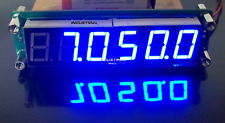
Physicists at the University of California, San Diego who last year produced a new class of composite materials believed to reverse the behavior of many fundamental electromagnetic properties associated with materials, have experimentally verified the first of these predicted reversals.
Their experiments, detailed in the April 6 issue of Science, demonstrate that electromagnetic radiation travels through the composite material in a manner never before seen in nature.
The achievement is much more than a physical curiosity. The new material could prove useful in the development of novel antennas and other electromagnetic devices. It may also make possible the construction of a “perfect lens,” capable of focusing light and other forms of radiation to limits not achievable by normal lenses.
In their experiments, the UCSD physicists built a sample of their material small enough to fit in a hand out of fiberglass and tiny copper wires. They then sent microwaves through it-at the same frequency as those used in police radar guns. What they discovered is exactly what was predicted a year ago-that the microwaves would emerge from the sample in a direction opposite to that predicted by Snell’s law, which describes the angle of refraction produced by the slowing of light and other forms of electromagnetic radiation through water, glass and other ordinary material.
“If these effects turn out to be possible at optical frequencies, this material would have the crazy property that a small flashlight shining on a flat slab would produce a focus at a point on the other side,” says Schultz. “There’s no way you can do that with just a flat sheet of ordinary material.”
Physicists measure the bending of light, microwaves and other forms of radiation through a material by its “index of refraction.” The bigger a material’s index, the slower light travels through it, and the more it “bends,” or changes direction when going from one material to a different one. Air, for example, has a refractive index of 1.0 for light; water, 1.3; and glass, about 1.5. This means that a beam of light passing from air to water is deflected in one direction by a certain amount and is deflected by glass by a slightly greater angle in the same direction. This bending, in combination with the curved glass surfaces, is what allows lenses to focus their light.
Electromagnetic radiation traveling through ordinary materials is always deflected in the same direction, giving those materials a “positive index of refraction.” But because the composite material constructed by the UCSD physicists bends electromagnetic radiation in the opposite direction, it is unique in possessing a “negative index of refraction.”
“This is the first demonstration of any material which has a negative index of refraction,” says Smith. “Since no existing material has this property, we needed to demonstrate the effect using a ‘metamaterial’-a composite material fabricated from repeated elements, specifically engineered to produce a desired electromagnetic behavior.”
The UCSD researchers have filed a patent application covering the construction of the new composite material. Their study was supported by the Defense Advanced Research Projects Agency, or DARPA, and the Air Force Office for Science Research, or AFOSR, which are investigating potential applications.
The concept of metamaterials has been recently introduced as part of a new DARPA initiative. Earlier this year, researchers at Marconi Caswell in England and London’s Imperial College demonstrated improvements to a magnetic resonance imaging system (MRI) using a magnetic metamaterial based on a structure similar to that of the structure developed by the UCSD team.
Intrigued by the possibilities of the UCSD metamaterial, John Pendry, a physicist at Imperial College who laid the groundwork for the UCSD development through his earlier publications, last fall published a paper in the journal Physical Review Letters, asserting that a material with a negative refractive index could make a “perfect lens.” This is because such a lens would not be limited by a diffraction limit, a condition that now prevents an ordinary lens from focusing the light that enters its surface into a spot smaller than approximately half a wavelength in diameter.
Although the composite material constructed by the UCSD physicists cannot focus visible light, that obstacle may one day be removed in future negative refractive index materials. “We don’t believe that’s a fundamental limitation,” says Schultz. “We may be able to find a way to go to visible light someday.”
The material used for the experiment-which consists of a series of thin fiberglass sheets coated with copper rings and wires, and arranged into squares like the interlocking inserts in a case of wine-was painstakingly constructed by Shelby based on a computer-assisted design. While it behaves in a manner consistent with the laws of physics, the composite exhibits a reversal of one of the “right-hand rules” of physics which describe a relationship between the electric and magnetic fields and the direction of their wave velocity.
As a result, it is part of a class of materials the UCSD physicists refer to colloquially as “left-handed materials,” after a term coined by Russian theorist V. G. Veselago, who predicted the possibility of such materials in 1968, because they reverse this relationship as well as many of the physical properties that govern the behavior of ordinary materials.
Another property the material is predicted to reverse is the Doppler effect, which makes a train whistle sound higher in pitch as it approaches and lower in pitch as it recedes. According to Maxwell’s equations, which describe the relationship between magnetic and electric fields, microwave radiation or light from a moving source would show the opposite effect in this new class of materials, shifting to lower frequencies as a source approaches and to higher frequencies as it recedes from an observer.


















Comments are closed.